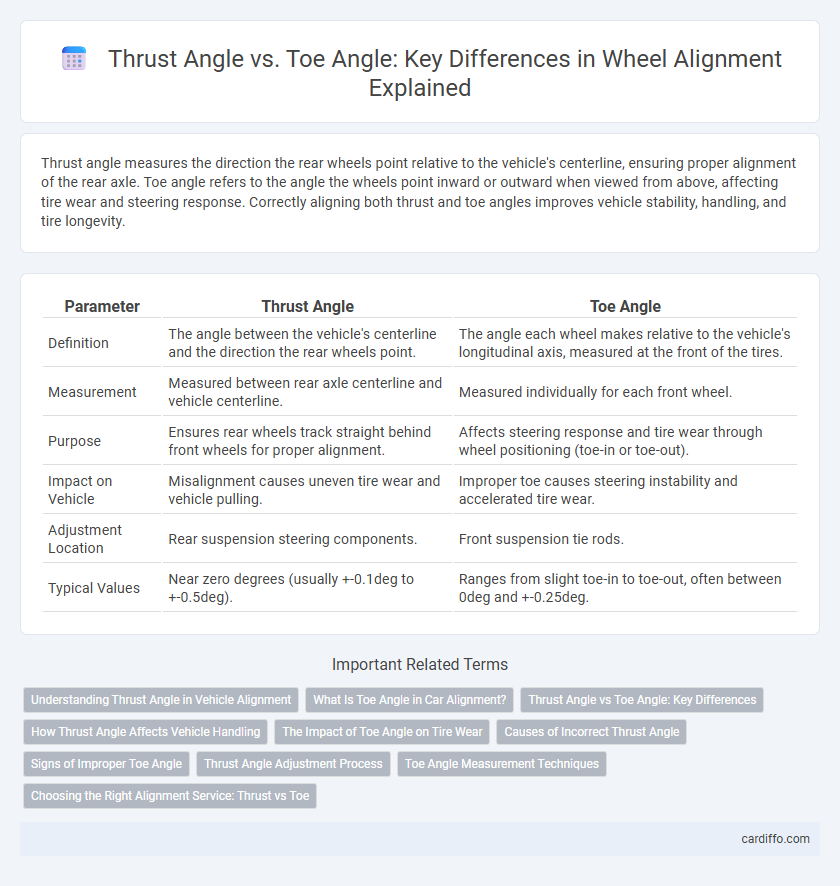Thrust angle measures the direction the rear wheels point relative to the vehicle's centerline, ensuring proper alignment of the rear axle. Toe angle refers to the angle the wheels point inward or outward when viewed from above, affecting tire wear and steering response. Correctly aligning both thrust and toe angles improves vehicle stability, handling, and tire longevity.
Table of Comparison
| Parameter | Thrust Angle | Toe Angle |
|---|---|---|
| Definition | The angle between the vehicle's centerline and the direction the rear wheels point. | The angle each wheel makes relative to the vehicle's longitudinal axis, measured at the front of the tires. |
| Measurement | Measured between rear axle centerline and vehicle centerline. | Measured individually for each front wheel. |
| Purpose | Ensures rear wheels track straight behind front wheels for proper alignment. | Affects steering response and tire wear through wheel positioning (toe-in or toe-out). |
| Impact on Vehicle | Misalignment causes uneven tire wear and vehicle pulling. | Improper toe causes steering instability and accelerated tire wear. |
| Adjustment Location | Rear suspension steering components. | Front suspension tie rods. |
| Typical Values | Near zero degrees (usually +-0.1deg to +-0.5deg). | Ranges from slight toe-in to toe-out, often between 0deg and +-0.25deg. |
Understanding Thrust Angle in Vehicle Alignment
Thrust angle refers to the direction that the rear wheels point in relation to the vehicle's centerline, crucial for maintaining proper alignment and straight vehicle tracking. Unlike toe angle, which measures the angle of each wheel relative to the vehicle's longitudinal axis, thrust angle specifically indicates whether the rear axle is properly aligned with the front axle. Correct thrust angle ensures balanced tire wear, improved fuel efficiency, and precise steering control, preventing the vehicle from pulling to one side during driving.
What Is Toe Angle in Car Alignment?
Toe angle in car alignment refers to the angle at which the tires point inward or outward when viewed from above, measured relative to the vehicle's centerline. Proper toe settings are crucial for ensuring even tire wear and stable handling, as incorrect toe can lead to increased tire friction and reduced fuel efficiency. Understanding toe angle allows for precise adjustments that optimize vehicle performance and safety on the road.
Thrust Angle vs Toe Angle: Key Differences
Thrust angle refers to the direction the rear wheels aim compared to the vehicle's centerline, affecting overall alignment and stability, while toe angle measures the inward or outward tilt of individual wheels relative to the vehicle's longitudinal axis. Thrust angle misalignment causes the vehicle to push or drift sideways, necessitating correction to prevent uneven tire wear and handling issues, whereas improper toe angles directly impact steering response and tire longevity. Understanding the distinction between thrust angle and toe angle is essential for precise wheel alignment, ensuring optimal vehicle control and tire performance.
How Thrust Angle Affects Vehicle Handling
Thrust angle directly influences vehicle handling by determining the direction in which the rear wheels align relative to the vehicle's centerline, impacting stability and tire wear. An incorrect thrust angle causes the vehicle to pull to one side, resulting in uneven tire wear and compromised steering response. Accurate adjustment ensures balanced handling, improved traction, and optimal tire performance during cornering and straight-line driving.
The Impact of Toe Angle on Tire Wear
Toe angle significantly influences tire wear by altering the direction tires point relative to the vehicle's centerline, causing uneven tread wear and reduced tire lifespan. Excessive toe-in or toe-out generates scrubbing forces during driving, increasing friction and accelerating tire degradation, particularly on the inner or outer edges. Proper toe angle adjustment optimizes tire contact with the road, ensuring uniform wear, improving vehicle handling, and enhancing fuel efficiency.
Causes of Incorrect Thrust Angle
Incorrect thrust angle often results from uneven tire wear, damaged suspension components, or misaligned rear axle, causing the vehicle to pull to one side. Impact from potholes or curb strikes can bend suspension arms or control arms, leading to inaccurate thrust angle measurements. Worn wheel bearings or frame damage may also distort the alignment, necessitating precise diagnostic checks to identify and correct the underlying issues.
Signs of Improper Toe Angle
Improper toe angle can cause uneven tire wear, especially on the inner or outer edges, leading to reduced tire lifespan. It often results in vehicle pulling to one side, causing steering instability and increased rolling resistance. Excessive toe-in or toe-out negatively impacts fuel efficiency and can strain suspension components.
Thrust Angle Adjustment Process
Thrust angle adjustment is a critical step in vehicle alignment that ensures the rear axle's direction aligns precisely with the vehicle's centerline, preventing uneven tire wear and steering instability. This process involves measuring and correcting the angle formed between the vehicle's thrust line and its geometric centerline, primarily by adjusting the toe angles of the rear wheels. Accurate thrust angle adjustment optimizes vehicle handling and extends tire life by maintaining proper rear wheel alignment in relation to the front wheels.
Toe Angle Measurement Techniques
Toe angle measurement techniques primarily involve the use of precision alignment tools such as laser systems, wheel alignment machines, and camber gauges to ensure accurate readings. Employing sensors and imaging technology enhances the detection of subtle deviations, enabling real-time adjustments to optimize tire performance and reduce wear. Accurate toe angle measurement directly impacts vehicle handling and stability, making advanced measurement techniques essential in modern automotive alignment processes.
Choosing the Right Alignment Service: Thrust vs Toe
Thrust angle alignment measures the direction the rear wheels point relative to the vehicle's centerline, ensuring the rear axle is properly aligned with the front wheels. Toe angle alignment adjusts the angle at which the front wheels point inward or outward to optimize tire contact and handling performance. Choosing the right alignment service depends on whether the vehicle shows signs of uneven rear wheel tracking (thrust angle issue) or front tire wear and steering instability (toe angle issue).
Thrust angle vs toe angle Infographic

 cardiffo.com
cardiffo.com